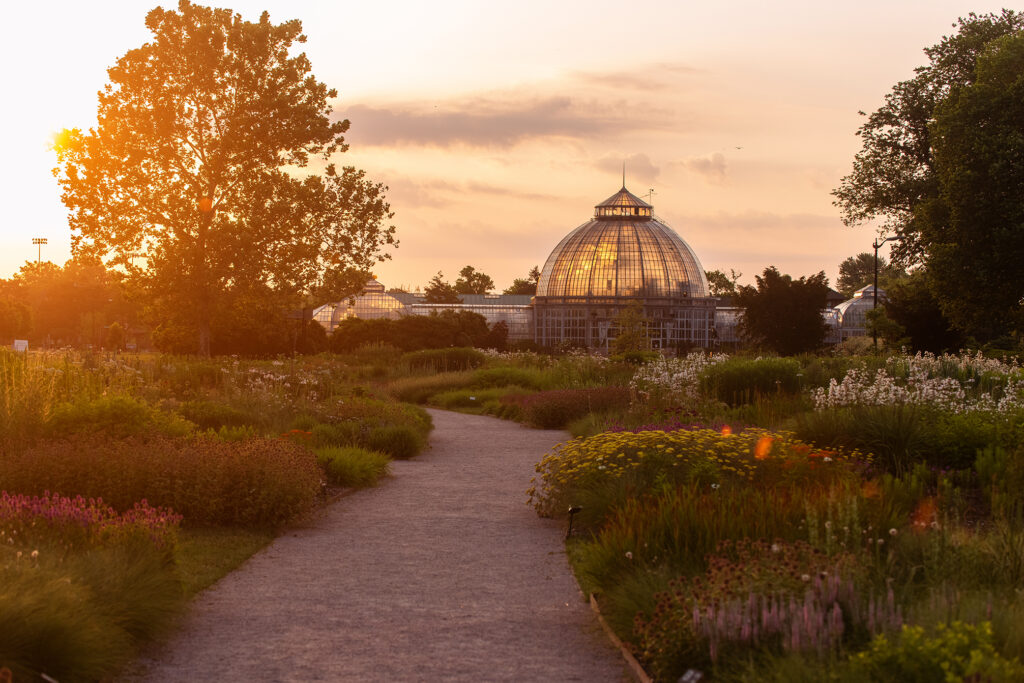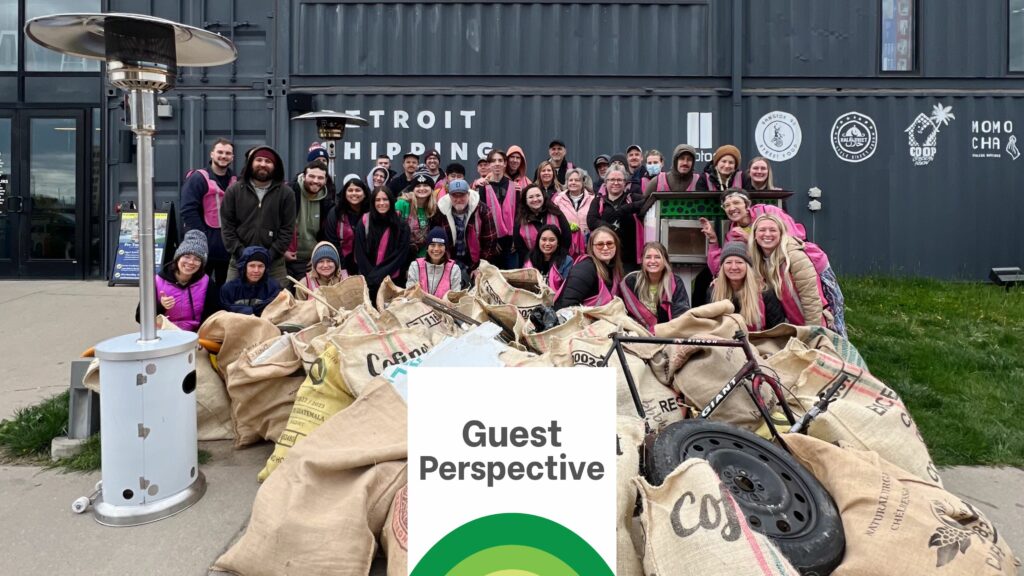New Leadership to Focus on Sustainability, Connectivity, Infrastructure

Meagan Elliott began her tenure as president and CEO of the Belle Isle Conservancy on July 1, following a decade with the city of Detroit, culminating in serving as chief parks planner and deputy CFO overseeing development and grants. Elliott spearheaded the Joe Louis Greenway Framework Plan and played a pivotal role as the city lead in a $350 million campaign for a unified greenway encompassing the Joe Louis Greenway and the Detroit Riverfront. The Belle Isle Conservancy is dedicated to safeguarding the natural environment, preserving historic structures, and enhancing Belle Isle as a public park for the enjoyment of all, now and in the future. According to the Michigan Department of Natural Resources, 5.6 million people visited the park last year. SBN Detroit interviewed Elliott about the conservancy’s approach to sustainability and what impacts her work will have on Southeast Michigan businesses and residents. Q: What part will sustainability play in your new role? A: Sustainability is fundamental to everything we do, and I want to lift and advance it in new ways. The Belle Isle Conservancy has done and continues to do a lot of work toward this. One example is the Keep Belle Isle Beautiful campaign focused on reducing plastic waste on the island and in waterways. That initiative has taken off and now goes far beyond the cleanups themselves, focusing on environmental stewardship and informing educational programming that helps to drive our future leaders. Caring for our planet forms the foundation of all our endeavors and is a filter for how we approach all our work, whether it be in support of habitat restoration, capital projects on the island, or new types of programming moving forward. I’m eager to collaborate with the Michigan Department of Natural Resources in this effort. Q: How does your background position you for this role? A: It’s in a couple of important ways. My tenure as chief parks planner was particularly formative, involving comprehensive work across all city green spaces, from neighborhood parks to a 30-mile greenway. When we consider Detroit’s park infrastructure, connectivity emerges as a fundamental concept. Historically, Belle Isle has been perceived as a separate entity and not easily accessible. Moreover, with one in four people in Detroit lacking access to a vehicle, they face challenges moving around the city, being able to access our amazing metro parks system, or getting Up North. Belle Isle is a treasure that rivals all of these spaces, and here it is right in our front yard. Connecting to a system of green space via the riverfront and the Joe Louis Greenway is essential. Connectedness extends beyond physical spaces to encompass the desires of residents and businesses surrounding Belle Isle as well. The Belle Isle Conservancy plays a crucial role as a steward and advocate, driving initiatives that reflect community wants and needs. Also, my background in sociology has prepared me to spend time listening to residents and how they want to utilize their island and to make sense of the patterns that emerge in engagement with a diversity of constituents. Finally, I’ve spent the last three years as deputy CFO brokering partnerships between private funders, philanthropic entities, and public partners and making initiatives happen by creating coalitions of folks. I want to put that same energy and investment behind Belle Isle. Q: You led the Joe Louis Greenway Framework Plan, and were the city lead in the $350 million campaign for a unified greenway for the Joe Louis Greenway and the Detroit Riverfront Conservancy. How will this impact your work going forward? A: I have an example. On my first day as president and CEO of the Belle Isle Conservancy, I was speaking at a press conference during which $20.7 million was received from the federal government for the continuing construction of the Joe Louis Greenway. This was a grant that the team worked on while I was still working for the City of Detroit. But I was there as the co-chair of the Joe Louis Greenway Partnership and was able to highlight the connection from the Joe Louis Greenway to the Iron Belle Trail, which ultimately will connect Belle Isle to Ironwood at the tip of the Upper Peninsula through a network of greenways. Many individuals have dedicated themselves to this work for a long time, and I’m committed to utilizing my platform and voice to continue to advance this work. Belle Isle is the epicenter of both this amazing network of green spaces and the Great Lakes. I can’t imagine a better geography for foregrounding environmental stewardship than on this island. Q: What impact do you think the Belle Isle Conservancy has on businesses in Southeast Michigan? A: I see the economic impact of public space as vast. It directly relates to employee decisions on where they choose to live and work. Belle Isle ranks as the second most visited park in the country after Niagara Falls. I believe our efforts here are directly linked to attracting new talent to businesses in Southeast Michigan and bolstering our economy. Q: In what way will you work with area businesses? A: The conservancy already does a lot of work with businesses on many fronts. One of the most immediately valuable impacts businesses have on Belle Isle is our corporate stewardship days. Businesses bring their teams to help clean up the park and connect with each other. We also have a significant number of partners in the corporate community who see the value of Belle Isle for the community and invest in projects to help support the park. We also have the opportunity to look at the vendors utilized on the island and how to create more inroads for Detroit-based businesses to play a role in the construction, management, concessionaire, and other vendor partnerships. There are endless opportunities to work together. Q: What challenges do you expect to encounter from a sustainability aspect? A: The challenge is always prioritization and how to choose projects and
The Cleanup Club: Working to Mitigate Plastic Pollution in the Great Lakes

HANNAH TIZEDES IS THE FOUNDER AND EXECUTIVE DIRECTOR OF THE CLEANUP CLUB Before founding The Cleanup Club, a nonprofit dedicated to protecting our communities and Great Lakes from plastic pollution through cleanups and creativity, I amassed a collection of over 100,000 pieces of plastic debris from the Great Lakes shorelines during solo cleanups. I used the colorful found objects to create thought-provoking art pieces and installations to inspire conversations about how we can all play a role in protecting the places we love. Creativity has continued to play a key role in The Cleanup Club’s mission to protect our communities and Great Lakes from plastic pollution while having fun. We aim to serve as an approachable source to help educate and spark dialogue with people online and in person about the urgent need for action to protect our freshwater resources. In 2016, a study from the Rochester Institute of Technology revealed that nearly 22 million pounds of plastic pollution enter our Great Lakes every year, with major cities such as Detroit, Chicago, and Toronto being primary sources. By 2024, plastic production has continued to increase globally, and so has the urgent need to protect our waterways from harmful impacts. This is particularly crucial as these bodies of water provide drinking water to over 40 million people across the US and Canada. Recent studies have shown that topics such as climate change and plastic pollution often leave people feeling frightened and negative. With the rise of terms like “eco-anxiety” and studies emphasizing the growing harms of plastic pollution, The Cleanup Club aims to push forward crucial work for a more sustainable future and cleaner waters. At the same time, we strive to create an uplifting community that empowers individuals, communities, and businesses to take action together through joyful and collaborative experiences. We understand that working together is essential when it comes to finding upstream solutions and mitigating plastic pollution in our region. This is why The Cleanup Club values collaborating with aligned local businesses and global brands. We aim to educate and expand the conversation about Great Lakes plastic pollution through community cleanups, educational programming, and interactive creative projects around Michigan, focusing on Southeast Michigan. When partnering with The Cleanup Club, local businesses enjoy the benefit of a passionate group of volunteers cleaning up their neighborhoods while driving awareness and business to their unique offerings. Past partners, contributors, and sponsors include Walking Lightly and 86 Plastic (local zero waste stores in Metro Detroit), Dessert Oasis Coffee Roasters, HiBAR, Detroit Shipping Co, Belle Isle Conservancy, Royal Oak Sustainability, and more. Community events are not only fun ways to get outside and take part in collective action but also serve as a way to collect data on top-polluting items and top-polluted areas for advocacy and research efforts that further promote upstream solutions. While we acknowledge that cleanups are not the ultimate solution, we strongly believe they play an accessible and active role in education and advancing our collaborative efforts for a brighter, more sustainable future for people and the planet. Learn more at www.thecleanupclub.org and follow on Instagram at @the.cleanup.club. Be sure to subscribe to our newsletter for regular updates on sustainable business practices in and around Detroit.


